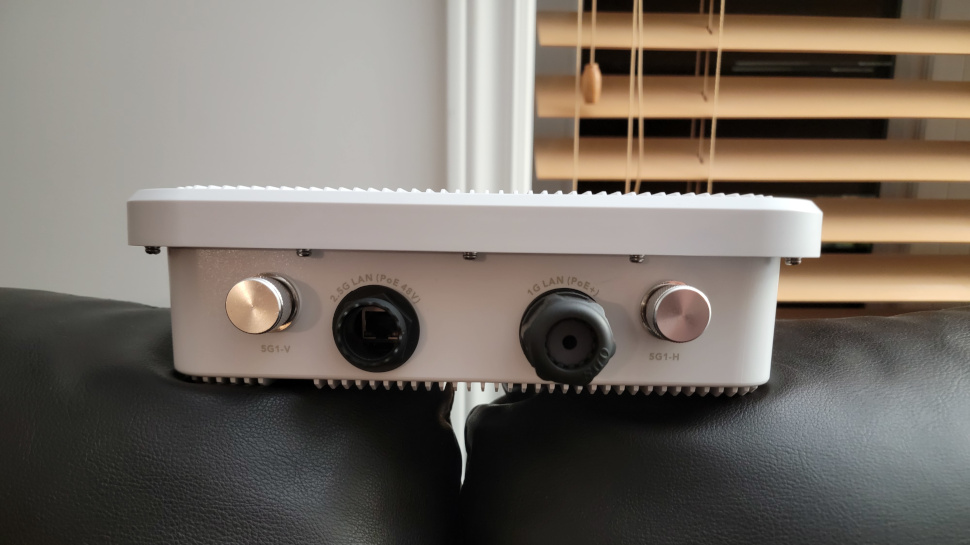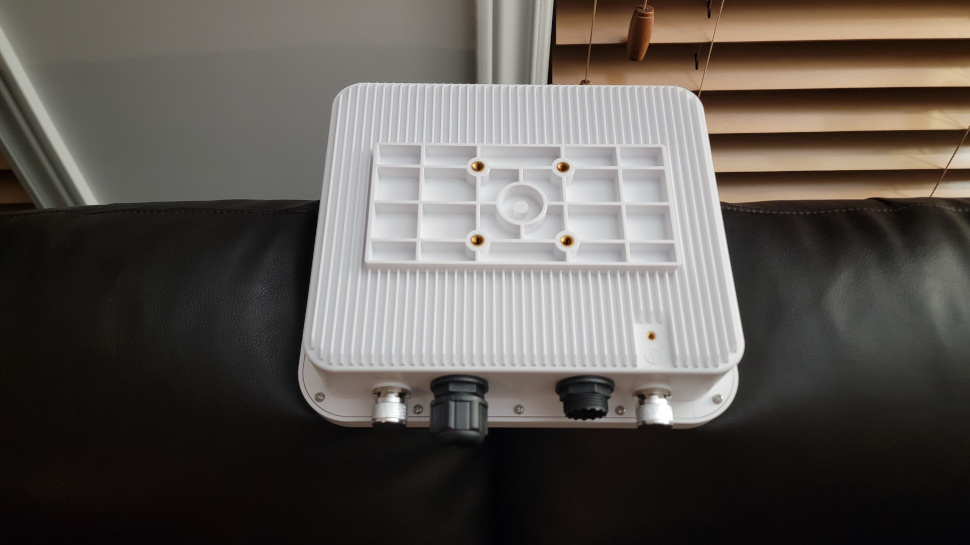Why you can trust TechRadar
We spend hours testing every product or service we review, so you can be sure you’re buying the best. Find out more about how we test.
The EnGenius EOC655 outdoor bridge features two Wi-Fi 6 radios offering a combined throughput of 2 Gbps.
Specification
CPU: Dual-core Qualcomm ARM CPU
RAM: 1GB
Storage: 8GB NAND
Radios: Two 2×2 5GHz Wi-Fi 6, One 2.4GHz Wi-Fi for management
Wireless throughput: Theoretical 2Gbps
Ports: 1Gb Ethernet with PoE, 2.5Gb Ethernet with proprietary PoE
Weight: 1.84 kg
Dimensions: 26.7 cm x 22.7 cm x 8.2 cm
Power Consumption: 21W maximum consumption, 15W with one client connected
MSRP: $999
The manufacturer-specified range of 10km is under ideal conditions. In reality, a reliable link is achieved at 1km or less. Its IP67 rating delivers reliable operation under harsh outdoor conditions, and with dual GbE ports, it can extend the reach of a remote location with wired Ethernet to over 100 meters. AES-256 encryption boosts security, and optional support for FIPS-140-2 compliance ensures reliable and secure communication.
The built-in GPS enables accurate device location and network mapping, making it essential for asset tracking and seamless network integration.
Web-based monitoring and management through the unified cloud service and mobile app allow auto-provisioning and large-scale deployments. The EOC655 consumes 21W, making it ideal for remote locations where energy supply is limited, such as a solar farm. A dual-core A53 CPU, supported by 1GB of RAM and 8GB of eMMC, provides premium features such as quality of service and VLAN support.
The EOC655 costs $999 per unit and does not include an external antenna. The same unit, equipped with two 18dBi antennas, costs $1100 and can cover up to 10 km. The EOC655 can be bundled with an even better antenna, providing up to 10km of range at higher throughput for $1300.
EnGenius EOC655: Design
The EnGenius wireless bridge ships with one accessory box containing the mounting kit, Ethernet wires, and a PoE adapter. A metal ring secures the unit to a outdoor post with screws. The white plastic enclosure lacks a heat dissipator and will become warm over time. Two Ethernet connectors link the box to the network while two N-type female connectors allow the addition of external antennas to boost the bridge’s range. The box measures 27 cm x 23 cm x 82 mm and weighs 1.84kg.
Internally, the EOC655 is based on a Qualcomm chipset. The processor is a Dual-Core 1GHz ARM CPU supported by 1GB of RAM and 8GB of flash memory. The two Ethernet ports can connect to 2.5 Gb and 1 Gb networks, supporting speeds as low as 10 Mbps. The connectors have a plastic enclosure that surrounds the Ethernet cable, preventing water from entering the bridge.
The two Ethernet ports function as PoE ports, but they differ slightly in operation. The 2.5 Gb port supports a proprietary version of PoE that is compatible only with the supplied adapter. The 1Gb port supports the regular 48V PoE and can be connected to a standard PoE switch. To facilitate installation, the bridge features additional hardware, including a GPS module and Bluetooth connectivity.
The two-radio architecture allows the use of both internal and external antennas. The maximum power for transmission is set to 27 dBm, which is higher than that of consumer products. The C18 model has built-in antennas with gains of 3.5 dBi at 2.4 GHz and eight dBi at 5 GHz. The second radio uses an N-type connector for the 5 GHz band. The base version of the bridge drops the 5GHz internal antenna, resulting in both radios operating through N-type connectors.

EnGenius EOC655: In Use
At least two units are needed to start the setup. A base unit connects to the wired network that needs extension. A second EOC655 is a subscriber and associates with the base over Wi-Fi 6. There is no visual indicator to show if things are working well. If a PoE switch is available, connecting the base unit will likely occur through the 1G port, as the faster 2.5G port is only compatible with the proprietary power supply.
The setup is entirely completed through the Engenius SkyConnect mobile app, available on Android and iOS. It is frustrating that an additional app is required for this process, as Engenius’s other products, including access points, utilize the more familiar Cloud-To-Go platform. Once powered, the base unit emits a management SSID and waits for remote units to reply. The EOC655 supports up to 16 subscriber stations, working in a star configuration. As such, adding stations won’t necessarily increase the network’s range.
Integrating a GPS module and a dedicated 2.4 GHz radio for management simplifies the installation process. The GPS provides real-time unit location and an accurate time source for the embedded NTP server. The 2.4GHz Wi-Fi and Bluetooth channels prevent downtime during Wi-Fi 6 radios configuration and firmware updates. Finally, a built-in compass provides additional help when no GPS signal is present.

EnGenius EOC655: Competition
The EOC655 bridge is an innovative product that combines various technologies, including Bluetooth and GPS, under a single roof. For this reason, it is challenging to find a suitable competitor.
The Zyxel WAX655E offers many features similar to those of the EnGenius, and it is faster, boasting a 4×4 radio architecture. The WAX655E lacks the convenience provided by the GPS module, making installation more difficult. The Zyxel product does not have a second Ethernet port, which prevents the network from being extended further without an Ethernet switch.
EnGenius EOC655: Final Verdict
The EOC655 meets the requirements when long-range Wi-Fi is needed. It’s not a router or an access point; it is pretty useless on its own. It shines when two or more are used in a mesh configuration to extend the reach beyond one kilometer. And it does it well. The installation is smooth, thanks to features such as geolocation via GPS and setup via Bluetooth or 2.4GHz Wi-Fi. The throughput isn’t the best, but it will be reliable over larger distances.
We appreciated that you could install external antennas, which offer better gain than embedded ones. However, the lack of visual cues on the unit makes working with the mobile app a necessity.
Buy the EOC655 if you want to extend the reach of your network without sacrificing reliability.
Don’t buy the EOC655 if you want the best throughput available.
We list the best mesh Wi-Fi systems.







Leave a Comment
Your email address will not be published. Required fields are marked *